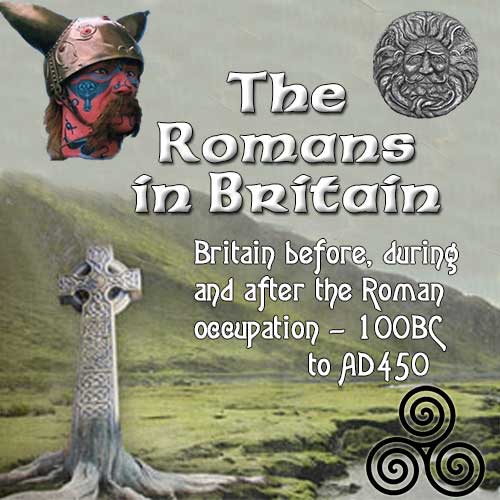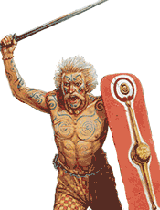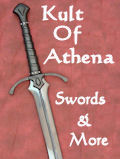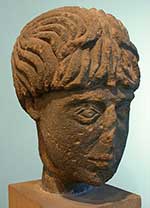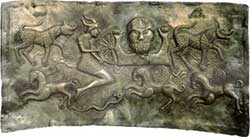Celtic Religion and Beliefs
The basic Celtic beliefs and superstitions
When humans cannot control something, they adapt. When they cannot understand something, they fear it. So it was in the Iron Age when Britain was ruled by tribes. Each had their own beliefs and philosophies, but all were very simliar. They could not understand, basic nature as we can today and the weather was the ruling factor in their lives. It decided whether the crops succeded or failed.. How many perished in the hard winters. How many of their livestock died in the snows. The tribes could not understand their surroundings, so they invented gods that they could worship. These gods could be pleased or annoyed by the actions of the people, which in turn had an effect on the well being of the tribe. To upset the gods, could result in a bad harvest and the tribes people would suffer by being short of food. If they made the gods favour them they would have a good harvest and win important battles fought against neighbouring tribes. Even so, the religion of Britain in pre-Roman times was based largely on superstition and tribal stories of ghosts and fears.
Most of the British people were made up of inhabitants whose families had been living in Britain since time began. But further south there had been an influx of foreign blood from Europe due to the constant savage wars that raged, especially between the Gauls and the Germans. These refugees had come to Britain to seek refuge from the turmoil and settle in a land that, they thought being an island, would give them a more peaceful existence.
As Britain became more commercialised and traded with the European neighbours, the infux of Belgic and Gaul immigrants brought new strains of Celtic religion to Britain.
The Druids
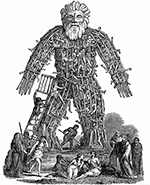 Although the Druids were
tribe, they were also a religion. and were the Druids were the most hated of the Celtic races.
Both by the neighbouring tribes and moreso by the Romans. Even by the standards of the more
aggressive tribes, they were feared and despised. They had originated in Europe where they had
been persecuted for their beliefs. The Romans saw them as savage barbarians who sacrificed
humans on altars to apease their gods. Human sacrifice was looked upo as the lowest act anyone
could perform upon another. The Romans in turn did sacrifice beings. The animals they
slaughtered would appease their gods. But human sacrifice would anger them. Yet the Romans would
quite openly sacrifice human lives in the arenas as their gladiators fought out their contests
to the death. Not to mention the fate that awaited the early Christians in the arenas of Rome.
Although the Druids were
tribe, they were also a religion. and were the Druids were the most hated of the Celtic races.
Both by the neighbouring tribes and moreso by the Romans. Even by the standards of the more
aggressive tribes, they were feared and despised. They had originated in Europe where they had
been persecuted for their beliefs. The Romans saw them as savage barbarians who sacrificed
humans on altars to apease their gods. Human sacrifice was looked upo as the lowest act anyone
could perform upon another. The Romans in turn did sacrifice beings. The animals they
slaughtered would appease their gods. But human sacrifice would anger them. Yet the Romans would
quite openly sacrifice human lives in the arenas as their gladiators fought out their contests
to the death. Not to mention the fate that awaited the early Christians in the arenas of Rome.
The Druids fled accross the channel and made their way accross country, into Wales and eventually to the relatively uninhabited island of Angelsey. Here they made their homes and settled hoping for peace and a stable lifestyle. Even though they had several hostile British tribes just a short distance away, they felt safe and secure. That was until the Romans arrived in Britain.
The Celtic gods
Antenociticus
Antenociticus — Antenociticus appears
at only one site in Britain, the fort of Condercum, on Hadrian's Wall, where three altars to
the god were found within the ruins of a small temple. This god is not mentioned on any
known Roman altarstones from the continent, and is therefore thought to be a native British
deity. The fact that the god is revered at Benwell (1327 [et Num Aug], 1328, 1329
[c.AD175-7]) by a legionary legate, the tribune of an auxiliary infantry cohort and the
prefect of an auxiliary cavalry ala,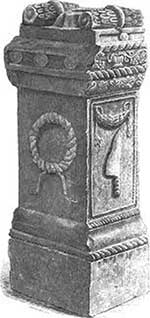 lends
credence to this assumption, and perhaps proves that the god was not transferred here as the
patron deity of an auxiliary regiment.
lends
credence to this assumption, and perhaps proves that the god was not transferred here as the
patron deity of an auxiliary regiment.
The sandstone head of the statue of Antenociticus was discovered in 1862 at the temple in Benwell. A torc can be seen around the neck, and the hair on the head curls forward so as to resemble two horns. Parts of the lower leg and forearm of the statue were also found, indicating that a life-sized statue of the god once stood in the temple.
The small temple of Antenociticus stands in the vicus (civilian settlement) outside Benwell (Condercum) Fort, one of 13 permanent forts added to the line of Hadrian's Wall during its construction. The temple was built in about AD 178-80, probably to mark the promotion of the Roman cavalry prefect who dedicated one of three altars in the temple to Antenociticus. It is thought Antenociticus was possibly worshipped as a source of inspiration and intercession in military matters.
Brigantia
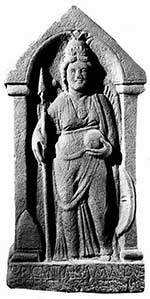 Brigantia "The High One," was patron
deity of the Brigantes tribe in northern Britain. Associated with water and springs, she was
also a goddess of poetry, learning, prophecy, and divination. Links with Minerva include a
spear and globe. Through interpretatio Romana, she was equated with Victoria. The tales
connected to the characters of Brigid and Saint Brigid in Irish mythology and legend have
been argued to be connected to Brigantia although the figures themselves remain distinct.
Brigantia "The High One," was patron
deity of the Brigantes tribe in northern Britain. Associated with water and springs, she was
also a goddess of poetry, learning, prophecy, and divination. Links with Minerva include a
spear and globe. Through interpretatio Romana, she was equated with Victoria. The tales
connected to the characters of Brigid and Saint Brigid in Irish mythology and legend have
been argued to be connected to Brigantia although the figures themselves remain distinct.
Brigantia was the equivalent of the Roman goddess Minerva (to the Greeks: Athena). In Ireland this Brigit was one of three goddesses of the same name, daughters of the Dagda, the great god of that country. Her two sisters were connected with healing and with the craft of the smith. Brigit was worshipped by the semi-sacred poetic class, the filid, who also had certain priestly functions.
Deae Matres
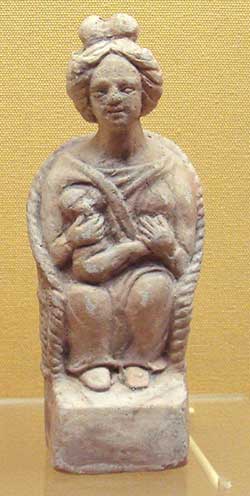 Deae
Matres ("Mother Goddesses") Usually seen as a trinity, these
fertility goddesses are often shown holding baskets of fruit, bread, or fish. The Deae
Matres were also associated with water and sacred springs, and sometimes fused with local
water deities such as Bath. Sculptures of the Matres also occur at Cirencester, Lincoln, and
London.
Deae
Matres ("Mother Goddesses") Usually seen as a trinity, these
fertility goddesses are often shown holding baskets of fruit, bread, or fish. The Deae
Matres were also associated with water and sacred springs, and sometimes fused with local
water deities such as Bath. Sculptures of the Matres also occur at Cirencester, Lincoln, and
London.
Dea Nutrix
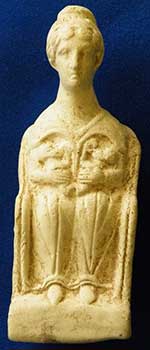 Dea Nutrix Another form of Mother Goddess is
"nursing mother" (Dea Nutrix). Clay statuettes of this goddess, mass-produced in
Gaul and exported to Britain, often show the young goddess seated in a high-backed wicker
chair nursing one or two infants.
Dea Nutrix Another form of Mother Goddess is
"nursing mother" (Dea Nutrix). Clay statuettes of this goddess, mass-produced in
Gaul and exported to Britain, often show the young goddess seated in a high-backed wicker
chair nursing one or two infants.
Epona
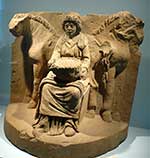 Epona The
Celtic horse goddess, popular in Gaul and Germany, spread to a lesser extent to
Britain via Roman cavalry troops. Epona was a protector of horses, ponies, donkeys, and
mules. She was particularly a goddess of fertility, as shown by her attributes of a patera,
cornucopia, ears of grain and the presence of foals in some sculptures. She and her horses
might also have been leaders of the soul in the after-life ride, with parallels in Rhiannon
of the Mabinogion. The worship of Epona, "the sole Celtic divinity ultimately worshipped in
Rome itself", was widespread in the Roman Empire between the first and third centuries AD;
this is unusual for a Celtic deity, most of whom were associated with specific localities.
Epona The
Celtic horse goddess, popular in Gaul and Germany, spread to a lesser extent to
Britain via Roman cavalry troops. Epona was a protector of horses, ponies, donkeys, and
mules. She was particularly a goddess of fertility, as shown by her attributes of a patera,
cornucopia, ears of grain and the presence of foals in some sculptures. She and her horses
might also have been leaders of the soul in the after-life ride, with parallels in Rhiannon
of the Mabinogion. The worship of Epona, "the sole Celtic divinity ultimately worshipped in
Rome itself", was widespread in the Roman Empire between the first and third centuries AD;
this is unusual for a Celtic deity, most of whom were associated with specific localities.
She is invoked in a small altar at Carvoran on Hadrian's Wall. While always depicted with horses, Epona is sometimes also shown with grain and a patera (offering bowl), which tie her to fertility and prosperity rituals.
Mogons
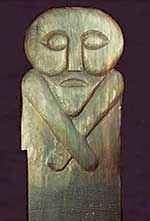 Mogons Dedications to this god, whom the Romans
identified with Apollo, occur at several fort sites around Hadrian's Wall, including
Netherby, Vindolanda, Risingham, and Old Penrith. Mogons was probably a Germanic import,
since the Latin name for Mainz is Mogontiacum.
Mogons Dedications to this god, whom the Romans
identified with Apollo, occur at several fort sites around Hadrian's Wall, including
Netherby, Vindolanda, Risingham, and Old Penrith. Mogons was probably a Germanic import,
since the Latin name for Mainz is Mogontiacum.
Mogons or Moguns was a god worshipped in Roman Britain and in Gaul. The main evidence is from altars dedicated to the god by Roman soldiers, but the deity is not a native Italic one. It appears to be Celtic. Inscriptional spellings include Mogetios, Mogounos, Mogti, Mounti, Mogont, Mogunt. Not all of these words are necessarily in the nominative case. For example, Mounti is a dative, probably *Mogunti, from a hypothetical nominative, *Moguns, of a back-formed Latin stem, *Mogunt-.
Etymologically the name can be seen to be the same as the English word Might personified. It has been translated by others as greatness or the great one. The fact that ordinary soldiers adopted him tends to support a "powerful" or "effective" interpretation rather than self-glorification.
Altar-stones raised to Mogons have been recovered in the United Kingdom.
The question of whether Moguns was Celtic or Germanic hinges to a large degree on the ethnicity of the Vangiones. As Belgae, they were considered Celts of Germanic origin. If they had still spoken Germanic, they would have been considered Germanic. Whether Celtic or Germanic, they were not the original population in the region, which had been purely Celtic, but must have been moved into it or allowed to settle there by the Romans. The Celts of Julius Caesar's time had evacuated the region through fear of the Suebi. The defense of the region against the latter is the main reason for the Roman base.
Rosmerta
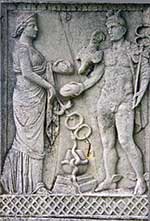 Rosmerta A Celtic goddess usually found as a
companion of the Celtic Mercury in Britain, Germany, and Gaul. She appears on a relief in
the Gloucester Museum holding a patera over an altar.
Rosmerta A Celtic goddess usually found as a
companion of the Celtic Mercury in Britain, Germany, and Gaul. She appears on a relief in
the Gloucester Museum holding a patera over an altar.
Rosmerta, a goddess loved by both Celtic and Roman Gauls was known as ”The Great Provider”. She is a goddess of fertility and wealth. She was worshipped in South-western Britain, Gaul, and along the Rhone and the Rhine rivers.
Rosmerta, Celtic Goddess painting by Judith ShawAfter the region was conquered by Rome, Rosmerta was incorporated into the Roman pantheon, becoming associated with Mercury. Though She has been called Mercury's consort there is no evidence that was the nature of their relationship. She survived in the Roman era as a powerful goddess in Her own right, being depicted alone many times. Alone and with Mercury, She carries a cornucopia and a basket of fruit, symbols of abundance. A giving goddess, She was often shown with a patera, a ritual offering bowl, and with a ladle or scepter.
Rosmerta has a unique attribute which has been difficult to decipher. Marian Green suggests that this attribute is a butter churn. In lands where cattle is wealth one would expect milk to be an important part of the economy and of religious ritual. It is not hard to imagine a link between Rosmerta's butter churn and the magic cauldrons found so often in Celtic mythology. Both are sources of plenty and transformation.
In addition Rosmerta was often depicted with the caduceus, Mercury's wand with two entwined snakes. The caduceus is associated with healing, making Rosmerta a healing goddess also. A bronze statue of Her from Haute-Savoie, a department in the Rhône-Alpes region of eastern France, shows Her sitting on a rock holding a purse with the wings of Mercury on Her head. Rosmerta with a purse suggests that she also bestowed abundance in the form of money. It seems that Rosmerta was able to not only share but also to appropriate Mercury's powers.
Sulis
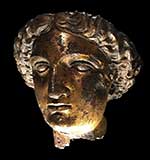 Sulis was the patron deity of the
thermal springs that still feed the spa baths at Bath (now in Somerset), which the Romans
called Aquae Sulis ("the waters of Sulis"). Sulis she was associated with water,
hot springs, and healing. The temple at Bath was dedicated to a composite goddess, Sulis
Minerva, as she was worshipped by the Romano-British — votive objects and
inscribed lead tablets suggest that Sulis was conceived of both as a nourishing, life-giving
mother goddess, and as an effective agent of curses wished by her votaries.
Sulis was the patron deity of the
thermal springs that still feed the spa baths at Bath (now in Somerset), which the Romans
called Aquae Sulis ("the waters of Sulis"). Sulis she was associated with water,
hot springs, and healing. The temple at Bath was dedicated to a composite goddess, Sulis
Minerva, as she was worshipped by the Romano-British — votive objects and
inscribed lead tablets suggest that Sulis was conceived of both as a nourishing, life-giving
mother goddess, and as an effective agent of curses wished by her votaries.
Sulis' name primarily appears on inscriptions discovered at Bath, with only a single instance outside of Britain at Alzey, Germany. This is not surprising, as Celtic deities often preserved their archaic localisation. They remained to the end associated with a specific place, often a cleft in the earth, a spring, pool or well. The Romans tended to lose sight of these specific locations, except in a few Etruscan cult inheritances and ideas like the genius loci, the guardian spirit of a place.
Taranis
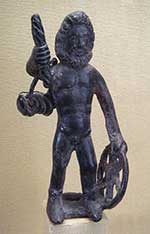 TaranisTaranis, is the god of thunder and
lightning (taren is Welsh for "thunder"), symbolized by a wheel. Taranis was worshipped
primarily in Gaul, Gallaecia, Britain, Ireland, but also in the Rhineland and Danube
regions, amongst others. Known archaeologically in Gaul and Germany, Taranis, along with
Esus and Toutatis as part of a sacred triad, was mentioned by the Roman poet Lucan in his
epic poem Pharsalia as a Celtic deity to whom human sacrificial offerings were
made. Taranis was associated, as was the cyclops Brontes ("thunder") in Greek mythology,
with the wheel.
TaranisTaranis, is the god of thunder and
lightning (taren is Welsh for "thunder"), symbolized by a wheel. Taranis was worshipped
primarily in Gaul, Gallaecia, Britain, Ireland, but also in the Rhineland and Danube
regions, amongst others. Known archaeologically in Gaul and Germany, Taranis, along with
Esus and Toutatis as part of a sacred triad, was mentioned by the Roman poet Lucan in his
epic poem Pharsalia as a Celtic deity to whom human sacrificial offerings were
made. Taranis was associated, as was the cyclops Brontes ("thunder") in Greek mythology,
with the wheel.
Taranis, is also known from nine inscriptions found in Italy, Germany, Hungary, Croatia, France and Belgium along with being linked to Jupiter in an altar from Chester. Taranis figures as the character of Taran in the Cymric (Welsh) Mabinogi of Branwen ferch Llŷr, is identified with Jupiter, as a warlord and a sky god. Based on writings in the ninth century comment on Lucan, the Berne Scholia, and descriptions in Caesar's De Bello Gallica, Taranis has been identified as the deity to whom both Julius Caesar and Strabo describe human sacrifices being offered by being burnt alive in 'wicker men'. The Berne Scholia also describes Taranis as a 'master of war', and links him with the Roman deity Jupiter.
The association of Taranis with Fire is clear from the figure and Caesar's words; the fire of the skies: the Sun, and the fire of the air: lightening and its voice thunder, giving the God his name, Taranis. 'Elsewhere we find Jove 'complete with wheel,' thought to represent the Celtic god of thunder, Taranis, who, hurling his wheel through the clouds, unleashed the terrible din. He turns up in 'classical' styles which must surely be official. A link is thus established from the little 'ritual wheels' of the Bronze and Iron Ages to the Gundestrup cauldron, and to representations of the Empires.'
Veteris
Veteris A warrior god, may represent a group of deities. At least seven versions of the same name are recorded in 54 inscriptions, most from the eastern half of Hadrian's Wall between Carvoran and Benwell. Based on the modest quality of these monuments, Veteris seems to represent a lower class cult. While linked at Netherby to the god Mogons, he is not identified with any Roman gods.
Horned God
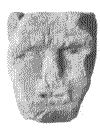 "Horned God" This unnamed god was widely dispersed
in Britain, especially in the south, where he was frequently linked with the Roman god
Mercury. He often appears with two short horns in uninscribed reliefs. Variants in Gaul have
stag antlers, with one inscription from Roman Paris identifying him with Cemunnos ("the
homed one").
"Horned God" This unnamed god was widely dispersed
in Britain, especially in the south, where he was frequently linked with the Roman god
Mercury. He often appears with two short horns in uninscribed reliefs. Variants in Gaul have
stag antlers, with one inscription from Roman Paris identifying him with Cemunnos ("the
homed one").

